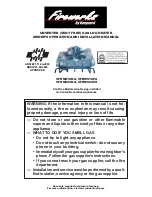
1104UESAGBEN, page 16/31
7. ELECTRICAL
SUPPLY
AND
CONNECTIONS
DANGER :
THIS APPLIANCE
MUST BE EARTHED.
Electrical supply
The electrical installation must only be carried out in accordance with the IEE regu-
lations and by an appropriately quali
fi
ed person. The electrical supply line to the
heater should include a main isolating switch. The minimum clearance distance
between the contacts must be more than 3 mm.
All electrical connections should be made in the heater control compartment (re-
fer
fi
gure ‘Wiring connections’). Screw type terminals are provided. Connections
should be in accordance with the terminal markings and the wiring diagram af
fi
xed
to the air heater.
Attention :
Permanent damage can occur to burner relay when faulty connection of thermo-
stat, reset switch or burner failure lamp.
Switching of wires for reset switch and
fl
ame failure (e.g. in a remote control box)
will destroy the burner relay.
The minimum external control required for the air heater is a room thermostat. It is
essential that the main input L and N terminals remain live at all times even when
the heater is switched off to ensure correct operation of the unit.
An external burner reset switch with red indicator light is
fi
tted on the heater. To
add a remote reset button, make connections to the terminals in the electric box as
indicated on the wiring diagram.
IMPORTANT: If the reset button requires activating for any reason, the cause must
be determined. After determining and correcting the problem, restart the heater
and monitor long enough to ensure proper operation (approx. 5 minutes).
An external orange indicator light is
fi
tted on the heater to signify when the burner
is on.
Ensure that all cables and installers wiring are appropriately
fi
xed and that they do
not touch the
fl
ue combustion collector box.
Do not attempt to control more than 1 heater from a single thermostat or control
panel unless a properly wired relay is
fi
tted. Follow the instructions supplied with
such panels.
The location of the room thermostat or sensor is very important. It should not be
positioned on a cold wall or cold surface. Avoid location in draughty areas or where
it may be in
fl
uenced by heat sources e.g. the sun, process plant, etc. The thermostat
should be mounted on a vibration free surface and mounted about 1,5 metres above
fl
oor level. Follow the thermostat manufacturers instructions.
Thermostat location
7.1 Electrical sup-
ply
















































